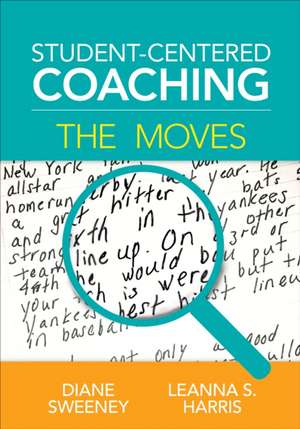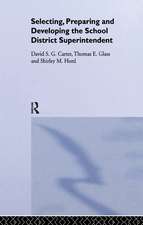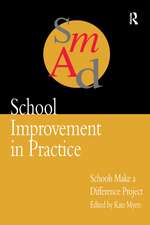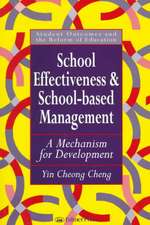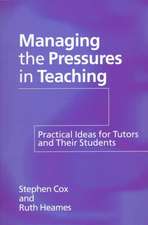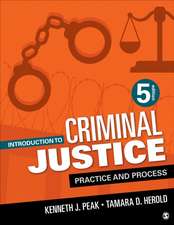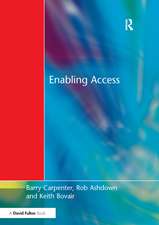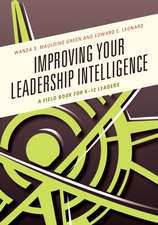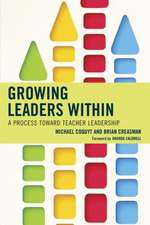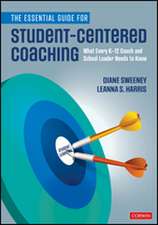Student-Centered Coaching: The Moves
Autor Diane Sweeney, Leanna S. Harrisen Limba Engleză Paperback – 5 feb 2017
Student-centered coaching is a highly-effective, evidence-based coaching model that shifts the focus from “fixing” teachers to collaborating with them to design instruction that targets student outcomes. But what does this look like in practice?
Student-Centered Coaching: The Moves shows you the day-to-day coaching moves that build powerful coaching relationships. This innovative book is the perfect companion to Diane Sweeney’s Student-Centered Coaching: A Guide for K-8 Coaches and Principals and Student-Centered Coaching at the Secondary Level. Readers will find:
- Coaching moves that can be used before, during, and after lessons
- An abundance of field-tested tools and practices that can be put to immediate use
- Original video clips that depict and unpack key moves
- Richly detailed anecdotes from practicing coaches that provide multiple access points and strategies
"This book contains many hands-on techniques that can serve coaches well in working with teachers (and students). It addresses a lot of the common pitfalls that occur when learning to be a coach. The book serves as a great tool for experienced coaches as well as those just entering into the position."
—Ann M. Lorey, Common Core Coach and Science Department Instructional Supervisor
Palo Alto Unified School District, CA
Preț: 276.20 lei
Nou
52.87€ • 57.45$ • 44.44£
Carte disponibilă
Livrare economică 31 martie-14 aprilie
Livrare express 14-20 martie pentru 24.92 lei
Specificații
ISBN-10: 1506325262
Pagini: 192
Dimensiuni: 178 x 254 x 15 mm
Greutate: 0.34 kg
Ediția:1
Editura: SAGE Publications
Colecția Corwin
Locul publicării:Thousand Oaks, United States
Recenzii
"This book contains many hands-on techniques that can serve coaches well in working with teachers (and students). It addresses a lot of the common pitfalls that occur when learning to be a coach. The book serves as a great tool for experienced coaches as well as those just entering into the position."
Cuprins
About the Authors
Introduction
Our Coaching Beliefs
Core Practices for Student-Centered Coaching
Student-Centered Coaching Is Driven by Formative Assessment Data
How Student-Centered Coaching Compares With Other Coaching Models
Moving Forward
Chapter 1: Setting Goals for Coaching Cycles
The Move—Setting Goals for Coaching Cycles
Why Setting Goals for Coaching Cycles Is Important
What Setting Goals for Coaching Cycles Looks Like
Lessons From the Field
Tools and Techniques
A Final Thought
Chapter 2: Using Learning Targets
The Move—Using Learning Targets
Why Using Learning Targets Is Important
What Using Learning Targets Looks Like
Lessons From the Field
Tools and Techniques
A Final Thought
Chapter 3: Getting Ready for Coaching in the Classroom
The Move—Getting Ready for Coaching in the Classroom
Why Getting Ready for Coaching in the Classroom Is Important
What Getting Ready for Coaching in the Classroom Looks Like
Lessons From the Field
Tools and Techniques
A Final Thought
Chapter 4: Noticing and Naming
The Move—Noticing and Naming
Why Noticing and Naming Is Important
What Noticing and Naming Looks Like
Lessons From the Field
Tools and Techniques
A Final Thought
Chapter 5: Micro Modeling
The Move—Micro Modeling
Why Micro Modeling Is Important
What Micro Modeling Looks Like
Lessons From the Field
Tools and Techniques
A Final Thought
Chapter 6: Thinking Aloud
The Move—Thinking Aloud
Why Thinking Aloud Is Important
What Thinking Aloud Looks Like
Lessons From the Field
Tools and Techniques
A Final Thought
Chapter 7: Sorting Student Work
The Move—Sorting Student Work
Why Sorting Student Work Is Important
What Sorting Student Work Looks Like
Lessons From the Field
Tools and Techniques
A Final Thought
Chapter 8: Providing Strengths-Based Feedback
The Move—Providing Strengths-Based Feedback
Why Providing Strengths-Based Feedback Is Important
What Providing Strengths-Based Feedback Looks Like
Lessons From the Field
Tools and Techniques
A Final Thought
Chapter 9: Measuring the Impact of Coaching
The Move—Measuring the Impact of Coaching
Why Measuring the Impact of Coaching Is Important
What Measuring the Impact of Coaching Looks Like
Lessons From the Field
Tools and Techniques
A Final Thought
In Closing
Appendix
Resource A—If/Then Charts
Resource B—Coaching Logs
Resource C—Language Stems
Resource D—Planning Tools
Resource E—Agreements and Protocols
Resource F—Results-Based Coaching Tool
References
Index
Notă biografică
Diane Sweeneyhas been an author and educational consultant since 1999. The author ofMoves for Launching a New Year of Student-Centered Coaching (Corwin, 2022), Student-Centered Coaching from a Distance(Corwin, 2021),The Essential Guide for Student-Centered Coaching(Corwin, 2020),Leading Student-Centered Coaching (Corwin, 2018), andStudent-Centered Coaching: The Moves(Corwin, 2016), Diane holds a longstanding interest in how adult learning translates to learning in the classroom. Diane holds a Bachelor¿s Degree from the University of Denver and a Master¿s in Bilingual and Multicultural Education from the University of Colorado, Boulder. After teaching and coaching in the Denver Public Schools, Diane served as a program officer at the Public Education & Business Coalition (PEBC) in Denver. Since then, she has become a respected voice in the field of coaching and professional development.
